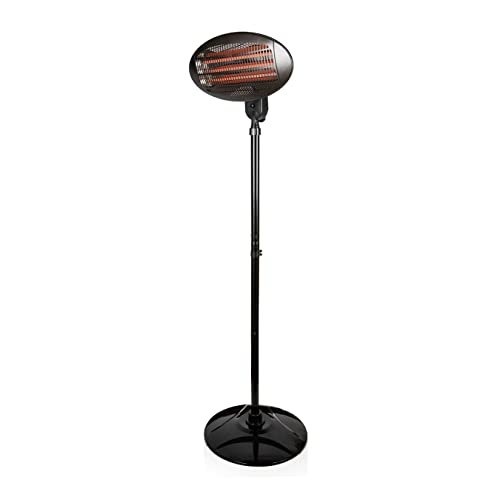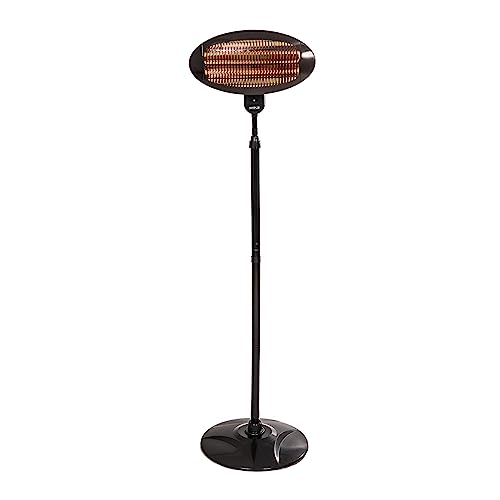Gas For Patio Heater
No matter if you are looking for patio heaters for private use or for restaurants the type of fuel source used by them will have an impact on cost and heat output. Gas-powered patio heaters can be found in three main varieties that include natural gas, propane and electric.

A natural gas patio heater is connected to your gas line at home and is never running out of fuel, but they require a professional installation.
Safety
Patio heaters can extend your outdoor season by bringing warmth. They come in a variety styles and are powered by propane, electricity or gas. Whatever fuel you select, there are important safety aspects to consider.
Propane is a well-known choice for patio heaters since it is non-toxic, and can be stored in small containers. It has an extremely low melting point and can therefore be used even in colder weather. Another advantage of propane is that it does not give off an unpleasant smell when burning.
The most important thing to do to keep your patio heater secure is to follow the instructions of the manufacturer for use and maintenance. Only household adults who are familiar with guidelines of the manufacturer should operate a patio heater and pets as well as children should be kept away from the unit at all times. Always ensure proper ventilation. Propane and natural gas patio heaters release deadly carbon monoxide if employed indoors or in a partially enclosed space.
If your patio heater is fitted with a thermocouple as well as a pilot, ensure that the access panel allowing you to reach them is securely secured. It is common for this access panel to get loose and shift too far from the pilot light, which causes the heater to shut down. In the majority of cases, you can correct this issue by using pliers to gently squeeze the two pieces closer.
You can further improve the security of your heater on your patio by adding heat shields and guards, and also by ensuring that it isn't placed near anything flammable. It is also crucial to have sufficient lighting around your fire table or patio heater. This can be achieved by ambient lighting or solar-powered walkway lights.
It is crucial to examine your patio heater frequently for signs of wear and tear. If you spot any damage or leaky parts, they should be replaced or repaired as soon as possible. It is recommended that the gas cylinder is stored in a protected place away from extreme weather conditions.
Cost
Gas patio heaters are available in a variety of sizes and offer a powerful heat output. They can warm a large area quickly and efficiently. This makes them a popular choice for commercial venues and large outdoor spaces. However, they usually cost more than electric heaters due to the fuel cost. Electric heaters also produce lower emissions and are in line with energy conservation and sustainability goals.
The performance and life span of your patio heater will be affected by the fuel you choose. Propane and butane are both commonly used as fuels for patio heaters, however there are some significant differences in their boiling points as well as the efficiency of their heating. Propane is generally preferred for its lower boiling point, meaning that it is able to function until temperatures drop to 40oC. Butane however, on the contrary side, starts to struggle to vaporise when temperatures drop below -420oC. This means that patio heaters using butane will start to run out of fuel in extremely cold conditions.
There are several factors that can impact the effectiveness of a patio heater such as design, type of gas used and environmental conditions. A freestanding patio heater is typically less efficient than one which is buried in ground because it loses heat to the air. The type of fuel you use can affect the efficiency, as natural gas heaters are typically more efficient than propane models.
Patio heaters come in a variety of sizes and styles, from tabletop to floor-standing. You can also select the propane or natural model and choose a wall-mounted, ceiling-mounted, or stand-alone model. Lowe's has a wide selection of propane patio heaters that have heating outputs that range from 9500 and 48000 BTU.
Although a gas patio heater is a great way to extend your outdoor season, it can be expensive to operate. The cost of operating gas heaters is generally more expensive than an electric model, and it requires a continuous supply of fuel. Before buying a product it is crucial to think about the maintenance requirements and security features.
A professional installer can assist you to determine the cost of installation. This includes local delivery of materials and equipment, as well as service transport from and to the job site the time for setting up and labor, as well as mobilization, and any cost for materials or services required to prepare the area. The estimate should include the cost to move, remove or alter existing framing, fixtures, surface finishes HVAC, electrical and plumbing systems and bring them up to current building standards.
Portability
Patio heaters can be a great way to increase the usability of outdoor spaces, whether at home or in a business. They can bring a warm light to the area and create an inviting centre for people to gather. They are well-liked in bars and pubs where they attract customers. People will spend longer at a table that has a patio heater in comparison to tables without.
Contrary to
electric patio heater vs gas heaters that are wired into the wall, and thus are restricted to the area the installation was made
black gas patio heater heaters can be moved from one location to another if needed.
gas heater for outdoor patio heaters are much more flexible than electric models that are typically restricted by the length or the size of the power cord. The majority of patio heaters are designed to be easy DIY assemblies, with all composite parts supplied with a thorough set of instructions on how to put them together. You can have your patio heater in less than one hour after it arrives without the need to call an electrician professional.
Gas patio heaters can be fueled by propane or butane liquefied petroleum gas (LPG) cylinders and they burn this fuel to produce heat. The flames that come from the burner are directed at an aluminum screen which is then reflected upwards to radiate the heat out into the surrounding area. A silvered hood on top of the burner reduces the loss of heat further by reflecting infrared down to the patio.
Propane
cheap patio gas heaters are very portable and offer a substantial amount of warmth for the smallest footprint. They are a good choice for those who want to warm their patios in the winter months, and can be used in conjunction with barbecues or fire pits to make the area more comfortable. Propane heaters are available in a variety of sizes and styles, so you can choose one that best suits your outdoor space.
The output of heat
When deciding on a patio heater, it is crucial to take into account the power output. This is measured in British Thermal Units (BTU). A higher BTU count means that the heater can provide more heat. Propane is a popular choice for heaters for patios because it has a lower boiling point than butane, and it performs well even in very cold weather. Propane can be used for all kinds of patio heaters.
Gas patio heaters can be a wonderful accessory to any outdoor space. It creates a warm and cozy atmosphere by radiating warmth that offsets the cold in the evening air. It is also ideal for restaurants and bars with outdoor seating areas, because people are more likely to sit and enjoy their meals or drinks in warm temperatures.
Patio heaters come in a variety of different designs, including the standalone gas towers you see in the exterior of many bars and restaurants and portable heaters that use propane tanks that are readily available. These heaters are suitable for both residential and commercial applications. They are reasonably inexpensive to run and produce enough heat for large outdoor areas. Some make use of a ceramic fascia to distribute heat, while others use a live fire that radiates energy into the space.
Some patio heaters are suitable for DIY assembly. These models include an entire set of instructions on how to put them together them. Installation of natural gas and propane heaters can be more challenging because they require an expert to install an electrical socket and connect them to the gas line.
Patio heaters that require a gas cylinder come with an additional burner on top of the pole, which burns propane, butane, or
natural gas gas patio heater gas LPG. A reflector is also included to help in directing heat and reduce loss of heat from conduction. These models also require a gas regulator that matches the pressure of the cylinder, to ensure safety and efficiency.
A patio heater requires adequate ventilation since it releases gases, including carbon monoxide and hydrocarbons. It should never be used in a confined area however, it should only be used in areas that are well ventilated. This is because a sealed space can increase the amount of oxygen in the air, which can cause carbon monoxide poisoning and other serious health problems.

 No matter if you are looking for patio heaters for private use or for restaurants the type of fuel source used by them will have an impact on cost and heat output. Gas-powered patio heaters can be found in three main varieties that include natural gas, propane and electric.
No matter if you are looking for patio heaters for private use or for restaurants the type of fuel source used by them will have an impact on cost and heat output. Gas-powered patio heaters can be found in three main varieties that include natural gas, propane and electric. A natural gas patio heater is connected to your gas line at home and is never running out of fuel, but they require a professional installation.
A natural gas patio heater is connected to your gas line at home and is never running out of fuel, but they require a professional installation.